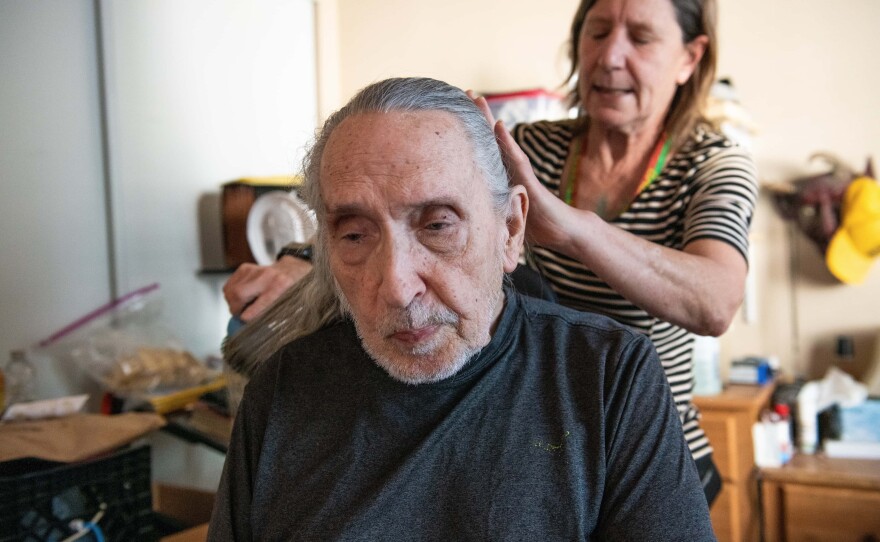In the next 10 years, adults over 65 will outnumber children under 18 for the first time in United States history, according to Census Bureau data. San Diego County’s senior population is projected to grow by more than 21% in that time. Also growing is concern about a group known as elder orphans — people who don't have the support of spouses, children or close family.
When Leon Christiansen was 65 years old, he got a brain bleed. For four days, he lay undiscovered in his apartment until concerned neighbors, noticing a smell, called for help. He said rescuers thought he was dead and took him to the morgue before realizing he wasn’t.
“I wasn't dead, dead. I was unconscious, you know, barely existing dead. I still had a breath, but not much,” Christiansen said.
Christiansen’s story, although rare, is a sobering example of the social isolation elder orphans face.
While it's hard to know the exact number of people who fit into this category, it's estimated that around 101,000 people over 65 live alone in San Diego County. That's about 21% of the senior population. National research supports that number. A 2020 study found that approximately one-quarter of Americans over 65 are considered to be socially isolated.
Christiansen is now 82. He never married or had children, although he said he came close a few times. It’s been more than 20 years since he’s seen any family.
“I still have my second, third cousins and such. But they live on the other side of the country. Last time I saw them was at my mother's funeral back in 2002, and I haven't heard from anyone since,” he said. “But they have their folks and family, everything. And so, I'm not part of their world, and my world is me.”
Christiansen’s experience is becoming more common. He’s part of what UC San Diego Health researcher Dr. Ellen Lee describes as a steep increase in social isolation and loneliness among older adults. She attributes it to rising rates of childlessness, lower rates of marriage and the aging of baby boomers.
“So when you get older, the risk factors for becoming more likely to be isolated or alone, are increased. Like you're more likely to lose family and friends and significant others as they pass away. You're more likely to become more frail and less mobile,” Lee said. “So you're going to be more dependent on people with whose support you may or may not be able to access. So we do think that those rates are rising. How much is difficult to say.”
Lee said elder orphans often lack people to help them with functional support, simple tasks that become harder to accomplish as we age.
“So like people to help you get groceries, people to have to get medicines, people to drive you to the doctor versus even having, like an emotional, intimate relationship sort of that emotional support.”
She said it is challenging for clinicians to identify these individuals, making it difficult to manage the complexities involved in delivering care, especially if they don’t volunteer the information.
After his accident, Christiansen was left mostly paralyzed. He still has use of his left hand, but needs a motorized wheelchair to get around. He’s also legally blind and can only see shapes. He relies on caregiver support twice a week for a few hours.
They help him with grooming, making meals and sorting medications.
He said his caregivers represent family to him.

Christiansen lives at a senior residence in the East Village of San Diego. He said he’s not the only one living there alone.
“Of the individuals I know here, at least six of them have no other immediate family except us,” Christiansen said.
Research has linked social isolation and loneliness in older adults to higher risks for a variety of physical and mental conditions, such as high blood pressure, heart disease, depression and cognitive decline.
The San Diego nonprofit Serving Seniors helps low-income elders with health services and meal deliveries. CEO Paul Downey said the center serves a large number of elder orphans.
“We see a significant number of people that live alone, that family either isn't there, they're estranged from, but they're by themselves and so they have to cope with everything. They don't have anybody to talk to,” Downey said.
He said economic insecurity adds another burden, with about 1 in 5 seniors living on about $1,500 a month in San Diego County. He hears about their financial struggles during mealtime conversations.
“Our biggest challenge is 86% of our seniors live below the federal poverty level,” Downey said. “Which means they are right on the cusp of homelessness.”
Experts say senior centers play a critical role in addressing this epidemic of loneliness by cultivating social connections. Whether it's a place to share a meal, take a fitness class or simply engage with others, senior centers can be a lifeline to many older adults who live alone.
Downey said the community also plays a vital role.
“If you have an older adult neighbor, go check on her, stop by and say hello. Bring them a cup of coffee. Go out of your way,” he said.
For Christiansen, his brush with death has given him a new perspective on aging alone.
“I’m quite happy being an orphan. Because I have survived death, I think every day is a good day.”
He keeps an open door policy so he can wave to friends as they pass by the hall.





